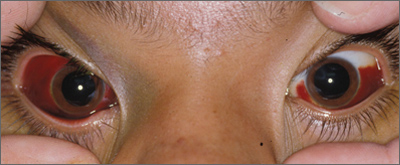User login
The FP diagnosed bilateral subconjunctival hemorrhages. The bright red color that goes up to the cornea but leaves a small white ring of uninvolved tissue at the limbus is a classic finding for subconjunctival hemorrhage. While a subconjunctival hemorrhage appears concerning, it is not dangerous to the eye.
When caring for a patient who presents in this manner, it’s important to check for uncontrolled hypertension. You’ll also need to ask about other bleeding so that you can rule out clotting problems.
In most cases, the subconjunctival hemorrhage is caused by mild trauma including sneezing and coughing. In this case, the FP reassured the patient that his subconjunctival hemorrhages would resolve spontaneously. She also suggested that the patient take antihistamines prophylactically before being exposed to a cat.
Text for Photo Rounds Friday courtesy of Richard P. Usatine, MD. Photo courtesy of Paul Comeau. This case was adapted from: Chumley H, Usatine R. Differential diagnosis of the red eye. In: Usatine R, Smith M, Mayeaux EJ, et al, eds. Color Atlas of Family Medicine. 2nd ed. New York, NY: McGraw-Hill; 2013:163-168.
To learn more about the Color Atlas of Family Medicine, see: http://www.amazon.com/Color-Family-Medicine-Richard-Usatine/dp/0071769641/ref=dp_ob_title_bk
You can now get the second edition of the Color Atlas of Family Medicine as an app for mobile devices by clicking this link: http://usatinemedia.com/
The FP diagnosed bilateral subconjunctival hemorrhages. The bright red color that goes up to the cornea but leaves a small white ring of uninvolved tissue at the limbus is a classic finding for subconjunctival hemorrhage. While a subconjunctival hemorrhage appears concerning, it is not dangerous to the eye.
When caring for a patient who presents in this manner, it’s important to check for uncontrolled hypertension. You’ll also need to ask about other bleeding so that you can rule out clotting problems.
In most cases, the subconjunctival hemorrhage is caused by mild trauma including sneezing and coughing. In this case, the FP reassured the patient that his subconjunctival hemorrhages would resolve spontaneously. She also suggested that the patient take antihistamines prophylactically before being exposed to a cat.
Text for Photo Rounds Friday courtesy of Richard P. Usatine, MD. Photo courtesy of Paul Comeau. This case was adapted from: Chumley H, Usatine R. Differential diagnosis of the red eye. In: Usatine R, Smith M, Mayeaux EJ, et al, eds. Color Atlas of Family Medicine. 2nd ed. New York, NY: McGraw-Hill; 2013:163-168.
To learn more about the Color Atlas of Family Medicine, see: http://www.amazon.com/Color-Family-Medicine-Richard-Usatine/dp/0071769641/ref=dp_ob_title_bk
You can now get the second edition of the Color Atlas of Family Medicine as an app for mobile devices by clicking this link: http://usatinemedia.com/
The FP diagnosed bilateral subconjunctival hemorrhages. The bright red color that goes up to the cornea but leaves a small white ring of uninvolved tissue at the limbus is a classic finding for subconjunctival hemorrhage. While a subconjunctival hemorrhage appears concerning, it is not dangerous to the eye.
When caring for a patient who presents in this manner, it’s important to check for uncontrolled hypertension. You’ll also need to ask about other bleeding so that you can rule out clotting problems.
In most cases, the subconjunctival hemorrhage is caused by mild trauma including sneezing and coughing. In this case, the FP reassured the patient that his subconjunctival hemorrhages would resolve spontaneously. She also suggested that the patient take antihistamines prophylactically before being exposed to a cat.
Text for Photo Rounds Friday courtesy of Richard P. Usatine, MD. Photo courtesy of Paul Comeau. This case was adapted from: Chumley H, Usatine R. Differential diagnosis of the red eye. In: Usatine R, Smith M, Mayeaux EJ, et al, eds. Color Atlas of Family Medicine. 2nd ed. New York, NY: McGraw-Hill; 2013:163-168.
To learn more about the Color Atlas of Family Medicine, see: http://www.amazon.com/Color-Family-Medicine-Richard-Usatine/dp/0071769641/ref=dp_ob_title_bk
You can now get the second edition of the Color Atlas of Family Medicine as an app for mobile devices by clicking this link: http://usatinemedia.com/

